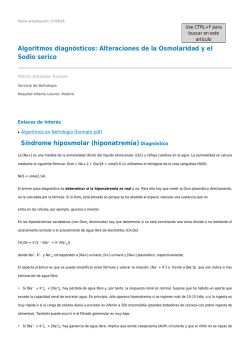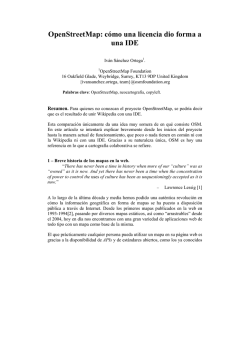
¿POR QUÉ ES IMPORTANTE LA HIPONATREMIA EN EL
IMPACTO Y MANEJO DE LA HIPONATREMIA EN GERIATRIA Sami Loutfi Jodra. Médico Geriatra. Servicio de Geriatría. Consorci Sanitari de Terrassa. ÍNDICE INTRODUCCIÓN ¿QUÉ ENTENDEMOS COMO HIPONATREMIA EN EL PACIENTE MAYOR? ¿QUÉ NOS DICEN LAS GUÍAS..? ¿QUÉ INCIDENCIA Y SEVERIDAD TENEMOS? ETIOLOGÍA IMPACTO ABORDAJE Y MANEJO INTRODUCCIÓN • Incluso pequeñas alteraciones de la natremia se asocian a peores resultados de salud • La edad y el bajo peso corporal como principales factores de riesgo. • Marcada disminución de la cantidad de agua corporal hasta en un 50%. Implicación en muchas funciones básicas (transporte, termoregulación, absorción de impactos y conductor de reacciones químicas) • Pacientes frágiles especialmente en riesgo. • Alteraciones electrolíticas son causa mayor de sarcopenia y deterioro funcional así como de deterioro cognitivo y caídas. Dehydration, hypernatremia and hyponatremia. John E.Morley. Clin Geriatr Med 31 (2015) 389-399 C.K.Mannesse et al. Ageing Research Reviews 12 (2013) 165-173 ¿QUÉ ENTENDEMOS COMO HIPONATREMIA EN EL PACIENTE MAYOR..? • Es la alteración electrolítica más habitual en pacientes mayores e ingresados, entendida como aquella <135mM/l. (corrigiendo por proteínas totales en plasma y glicemia) • SIADH como causa más frecuente. Entre un 26 y un 60% son idiopáticos. • ¡Erroneidad en el concepto de hiponatremia asintomática! Dadas las elevadas implicaciones de salud (daño cerebral, insuficiencia respiratoria, fracturas, déficit atencional, etc) • Indicador de mal pronóstico y de aumento de mortalidad Prevalence of Hyponatremia on geriatric wards compared to other settings over four decades: A systematic review.Agein Res Rev 12. 2013 R.Tolouian et al. The correlation of hip fracture and hyponatremia in the Elderly. Jnephrol 2012 (05):789-793. ¿Y QUÉ DICEN LAS GUÍAS DE PRÁCTICA CLÍNICA? Muchas veces olvidada y poco atendida por los diferentes clínicos. Se llega tarde y el impacto es mucho mayor. Según el especialista y la experiencia personal, existen diferentes estrategias diagnósticas y terapéuticas. En una revisión reciente sobre guías diagnóstico-terapéuticas, se constata que el 98% se basaban en bajos o muy bajos niveles de evidencia.. Prácticamente ninguna guía se basa en los valores y preferencias del paciente. (restricción hídrica)..Fundamental en Geriatría..! Nagler et al. BMC Medicine 2014, 12:231. Diagnosis and treatment of hyponatremia: a systematic review of clinical practice guidelines and consensus statements ¿QUÉ INCIDENCIA Y SEVERIDAD TENEMOS..? COMUNIDAD RESIDENCIAS Incidencia:1014,5% Severidad: 1% UNIDADES GERIATRÍA HOSPITALES AGUDOS Incidencia:22-25% Incidencia: 22,2% Incidencia al ingreso: 5%. 53% almenos un episodio/año Prevalencia: 14,8% Severidad: 4,5% Durante el mismo: Hasta un 60% 50% de riesgo mortalidad a los 3 meses (Na<130mMol/l). Dehydration, hypernatremia and hyponatremia. John E.Morley. Clin Geriatr Med 31 (2015) 389-399 C.K.Mannesse et al. Ageing Research Reviews 12 (2013) 165-173 ETIOLOGÍA HIPONATREMIA EUVOLÉMICA HIPONATREMIA HIPERVOLÉMICA HIPONATREMIA HIPOVOLÉMICA ETIOLOGÍA HIPONATREMIA EUVOLÉMICA Osm Plasma: baja; Vol. Urinario: variable Osm urinaria: >100; Na+ urinario: >40 SIADH (CAUSA MÁS FRECUENTE) Patología intracraneal (AVC, Tumores, infección) Tumores (pulmón, páncreas) Patología pulmonar (Neumonía, TBC) Cirugía Fármacos (ISRS, especialmente) Dolor crónico Nefrogénica (Alteración renal del receptor V2) HIPOTIROIDISMO ETIOLOGIA HIPONATREMIA HIPERVOLÉMICA Osm. Plasmática: baja; Osm. Urinaria: >100 Vol. Urinario: bajo; Na+ urinario: <20 INSUFICIENCIA CARDÍACA CIRROSIS HEPÁTICA SD. NEFRÓTICO INDUCIDA POR EJERCICIO (Excesiva ingesta líquidos durante ejercicio) ETIOLOGÍA HIPONATREMIA HIPOVOLÉMICA Osm plasmática: BAJA; Osm urinaria: >500 Vol. urinario: BAJO; Na+ urinario: <20 Diuréticos de asa/Tiazídicos Vómitos/Diarrea aguda Insuficiencia suprarenal (Enf. Addison) Hiperglicemia/Diabetes Mellitus FÁRMACOS RELACIONADOS FÁRMACOS MECANISMO DE ACCIÓN DIURÉTICOS (Tiazidas, de asa, Amiloride) Alteración homeostasis de sodio y agua ANTIDEPRESIVOS (Tricíclicos, ISRS, Monoamina oxidasa inhib.) Aumento hipotalámico de ADH ANTIPSICÓTICOS (Haloperidol) Aumento hipotalámico de ADH ANTIEPILÉPTICOS (Carbamacepina, Aumento hipotalámico de ADH Oxcarb, valproato, lamotrigina) ANTINEOPLÁSICOS Aumento hipotalámico de ADH MISCELÁNEA (MTX, Interferon alfa, Ac.M) Aumento hipotalámico de ADH OPIÁCEOS Aumento hipotalámico de ADH AINE’S Potenciación del efecto de la ADH ANTIHIPERTENSIVOS (IECA’s, Amlodipino) Conv. de A-I a A-II a nivel central ANTIBIÓTICOS (Cotrimoxazol, Ciprofloxacino) Natriuresis e hipovolemia con aumento de ADH OTROS (IBP’S, ANTIARRÍTMICOS, DULOXETINA, BUPROPIÓN) SIADH A Review of drug-induced hyponatremia. G.Liamis et al. American Journal of Kidney Diseases, vol 52, No1 2008. 144-153 IMPACTO DE LA HIPONATREMIA EN LA PERSONA MAYOR IMPACTO COGNITIVO IMPACTO FUNCIONAL IMPACTO EN LA FRAGILIDAD IMPACTO EN LA MORTALIDAD IMPACTO EN LA HOSPITALIZACIÓN IMPACTO DE LA HIPONATREMIA EN LA PERSONA MAYOR IMPACTO COGNITIVO DÉFICIT DETERIORO ATENCIONAL COGNITIVO DELIRIUM Mild Hyponatremia is associated with impaired cognition and falls in community-dwelling older persons. JAGS 2013-Vol 61, NO.10 Dehydration, hypernatremia, and hyponatremia. John E.Morley, MB. Clin Geriatr Med 31 (2015) 389-399 IMPACTO DE LA HIPONATREMIA EN LA PERSONA MAYOR Jamal SA et al. Hyponatremia and fractures: findings from the Osteoporotic Fractures in Men study. J Bone Miner Res 2014. Dehydration, hypernatremia, and hyponatremia. John E.Morley, MB. Clin Geriatr Med 31 (2015) 389-399 Mild Hyponatremia is associated with impaired cognition and falls. JAGS 2013. Vol 61 The Correlation of hip fracture and hyponatremia in the elderly. Jnephrol 2012; 25(05):789-793 IMPACTO DE LA HIPONATREMIA EN LA PERSONA MAYOR John E. Morley. Clin Geriatr Med 31 (2015) 389-399 Prognostic implications of hyponatremia in elderly patients. Chua et al. Arch of Geron and Geriatr 45 (2007) 253-258 IMPACTO DE LA HIPONATREMIA EN LA PERSONA MAYOR Hoorn EJ, Rivadeneira F, Van Meurs JB, et al. Mild hyponatremia as a risk factor for fractures; the Rotterdam study. J Bone Miner Res 2011;26(8). M.Chua et al. Arch of Gerontol and Geriatr 45 (2007) 253-258. Fegan, G.,Begley, J., 2005. Hyponatremia in the Elderly. CME Geriatr. Med. 7, 76-85. Allison, S.P.,Lobo, D.N 2004. Fluid and electrolytes in the elderly. Clin.Nutr. Metab.Care 7,27-33 Beck, L.H., 2000. The aging kidney. Defending a delicate balance of fluid and electrolytes. Geriatrics 55, 26-28. MORTALIDAD MORTALIDAD IMPACTO DE LA HIPONATREMIA EN LA PERSONA MAYOR Dehydration, Hypernatremia, and hyponatremia. J E. Morley. Clin Geriatr Med 31 (2015) 389-399 Ahamed S, Anpalahan M., Savvas S, et al. Hyponatremia in older medical patients: implications for falls and adverse outcomes of hospitalisation. Inter Med J 2014; 44(1):991-7. Prognostic implications of hyponatremia in elderly hospitalized patients. M.Chua et al. Arch of Geront and Geriatr. 45 (2007). 253-258. ABORDAJE Y MANEJO DE LA HIPONATREMIA EN LA PERSONA MAYOR ABORDAJE Y MANEJO DE LA HIPONATREMIA EN LA PERSONA MAYOR ¿HIPONATREMIA REAL? ¿TIENE SÍNTOMAS? ¿AGUDA O CRÓNICA? ¿CÓMO ESTÁ EL VOL. EXTRACELULAR? Real: Osm. Plasmática AGUDA: <48h. Bajo/normal/alto disminuída Náuseas/vómitos/cefalea/ desorientación (115-125) PseudoHiponatremia: Osm. Normal o aumentada (Hiperlipidemia, hiperproteinemia) Coma, convulsiones, muerte (<115) **Hipoxemia: FdR más importante asociado a muerte CRÓNICA:>48h. Crítico para tipo solución a utilizar (PO muy útil en Horacio J.Adrogué,MD. N.E.Madias. NEJM. Vol 342. Nº21. 2000 Dehydration, hypernatremia and hyponatremia. Clin Geriatr Med 31 (2015) 389-399 diferenciar hipo de euvolemia) ABORDAJE Y MANEJO DE LA HIPONATREMIA EN LA PERSONA MAYOR SIADH como diagnóstico de exclusión. Los pacientes deben: Estar euvolémicos Función suprarrenal y renal normal Tener bajo control el dolor y las náuseas Haber descartado hipotiroidismo grave No estar siendo tratados con diuréticos Osmolalidad plasmática baja (<275 mOsm/Kg.) Concentración inadecuada de la orina con ingesta normal de sodio RunKle I. et al. Reviews in Clinical Gerontology. 25(01). Feb 2015;31-52 ABORDAJE Y MANEJO DE LA HIPONATREMIA EN LA PERSONA MAYOR RunKle I. et al. Reviews in Clinical Gerontology. 25(01). Feb 2015;31-52 ABORDAJE Y MANEJO DE LA HIPONATREMIA EN LA PERSONA MAYOR La base del tratamiento es la RESTRICCIÓN HÍDRICA (bien hecha) Suspender fármacos de sospecha y realizar fórmula de Furst para orientar grado de restricción (Na orina+K orina)/Na plasmático.(≥ 1, NO responderán!) Restringir líquidos a < 500cc /dia conlleva malnutrición: Evaluar siempre antes el estado nutricional. EVITAR tratamientos/medidas que puedan empeorar su estado nutricional. (no >48h) Valorar: Furosemida (no viable con SIADH crónico pero sí en hospitalizados)/ClK/Tolvaptán OBJETIVO: la eunatremia RunKle I. et al. Reviews in Clinical Gerontology. 25(01). Feb 2015;31-52 ABORDAJE Y MANEJO DE LA HIPONATREMIA EN LA PERSONA MAYOR Si la restricción hídrica no es posible o no es factible y la Osm urinaria ha bajado a 350 o ha partido de 350, y puede beber: **TOLVAPTAN Gran beneficio en SIADH crónico e hiponatremia sostenida Mejora de la función cognitiva y motora con niveles sostenidos de eunatremia en plazo de 2-4 meses Asociado a disminución significativa de visitas a Ucias y tendencia a reducción del número de dias de hospitalización por reingresos. RunKle I. et al. Reviews in Clinical Gerontology. 25(01). Feb 2015;31-52 ABORDAJE Y MANEJO DE LA HIPONATREMIA EN LA PERSONA MAYOR VAPTANES: MECANISMO DE ACCIÓN A. Peri. The Use of Vaptans in Clinical Endocrinology. J Clin Endocrinol Metab, April 2013, 98 (4):1321-1332. ABORDAJE Y MANEJO DE LA HIPONATREMIA EN LA PERSONA MAYOR TOLVAPTÁN. Indicaciones. Preparación del paciente mayor para la cirugía Hiponatremia euvolémica e hipervolémica. (Estudios SALT-1, SALT-2 y SALTWATER) Con antecedentes de ICC. (Estudios: SALTWATER, EVEREST, ACTIV). Pacientes que necesitan nutrición artificial o suplementos proteicos Preparar el paciente para la Quimioterapia y durante la misma The Use of Vaptans in Clinical Endocrinology. J Clin Endocrinol Metab, April 2013, 98 (4):1321-1332 ABORDAJE Y MANEJO DE LA HIPONATREMIA EN LA PERSONA MAYOR DOSIFICACIÓN 15 mg/dia primer mes. Luego bajamos a 7,5 mg/dia. Luego a las 3-4 semanas: 7,5 mg. en dias alternos Luego 7,5 mg. 3 veces/semana Si ingreso: subimos a 7,5 mg./día. RunKle I. et al. Reviews in Clinical Gerontology. 25(01). Feb 2015;31-52 CONCLUSIONES ELEVADA INCIDENCIA ¡PENSAR EN ELLO! ALTO IMPACTO EN PACIENTE MAYOR TRATAMIENTO SIN DEMORA Y ETIOLÓGICO
© Copyright 2026


